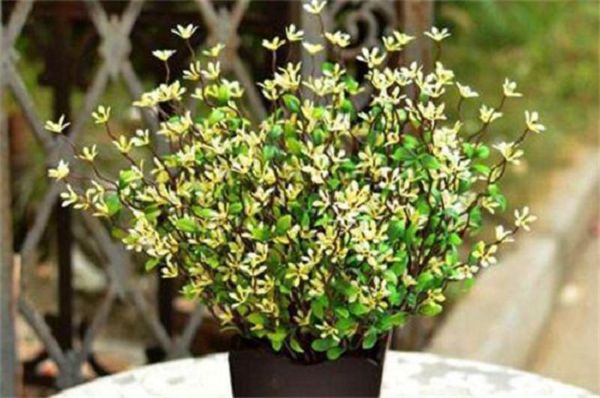Orchids neither grow nor die? Attention, it may be a stiff seedling.
Friends who have raised orchids should all encounter this situation. The orchids that had been carefully preserved finally produced new seedlings, but as a result, they stopped growing slowly. This must be a great disappointment to the flower friends. But the stiff seedlings of orchids do not necessarily die immediately, so this situation is easy to deceive people, if not often observed it is really difficult to find. And orchids with rigid seedlings, even if they grow up slowly later, are mostly deformed seedlings, affecting the beauty of the orchid plant. Then why did the new orchid seedlings stop growing? Let's take a look at it with Xiaozhi.
1. The environment is too bad
The quality of orchid culture environment can also affect the growth of new buds. New buds with good orchid environment grow healthily and healthily, while new buds with poor orchid environment are easy to get diseases and insect pests, rigid seedlings, rigid buds and so on. Once the new buds appear rigid seedlings, even if they can return to normal growth after a period of time, it will also affect the growth of the next generation of new buds, which will grow longer and weaker. Therefore, improving the environment of raising orchid is one of the most effective ways.
Solution: light is very important to the growth of orchid plants. When the light is insufficient, the orchid plant is weak and the leaves grow too long; if the light is too strong, the orchid leaves will be tanned or scorched, and the ornamental value will be greatly reduced. Therefore, all kinds of orchids need to be placed in a semi-overcast environment. Spring orchids and cymbidium require a little more light during the vigorous growth period in summer; the light needed for Jianlan is basically the same; and ink orchids need more sunlight.
Second, fertilization is too thick
Orchids fertilize too much to hurt the roots and scorched leaves, many flower friends have the habit of doing base fertilizer for orchids, in the allocation of soil, mixed with some fertilizer in the soil as base fertilizer. Although this will not affect, but if the base fertilizer is too thick, it will be easy to stiff seedlings, or even burn seedlings.
Solution: when orchids are on the pot, base fertilizer must be applied according to the growth of orchids. New buds generally grow in the season when the temperature is low, and there is basically not much medicinal fertilizer here. If you want to apply fertilizer, you should also pay attention to applying thin fertilizer, once every 15 to 20 days on average.
Third, too much watering
The orchid was overwatered for a long time or continuously drenched by rain, the soil air gap was filled, and the orchid root was anoxic and soaked for a long time, resulting in necrosis. Once the root is damaged, it will definitely be reflected in the leaves.
Solution: the growth of new buds is the critical moment for the growth of orchids. While observing the changes of new buds in different periods, we should observe the dry and humidity of plant materials on the basin, pay attention to control the amount of watering, and achieve "uneven drought and waterlogging". In addition, the orchid basin should be placed in the air to drain water quickly. Otherwise, the bottom of the basin is prone to water and rot.
IV. Aging of plant materials
This situation is that the maintenance for many years did not turn the basin for renewal, and the acid-base nutrients contained in the plant materials were out of balance, which led to the lack of nutrition of orchids, which directly affected the nutrient absorption of the roots, so the new buds were ossified.
Solution: in an appropriate time, change the pot and trim the roots of the plant, and replace the nutritious plant material in time.
Fifth, compete for nutrients
If the orchid seedling is born with a stronger new bud in the process of growth, it will cause the strong bud to seize the nutrients of the mother seedling, and the new bud will grow into a rigid bud after a long time. A stiff bud formed in a situation like this is basically impossible to grow up.
Xiaosik summed up
The most important way is to prevent in advance! First of all, it is necessary to provide various cultivation conditions and environment for orchid mother seedlings. If orchid mother seedlings can grow healthily again, then rigid buds may coruscate new machine vitality. If there is really an incurable disease, it is recommended to get rid of the pain, cut off the stiff buds, then deal with the wound, and finally smear the wound with bacterial powder.
- Prev

The culture method of Milan flower and how to raise it.
The culture method of Milan flower and how to raise it.
- Next

What are the pests of Milan flowers? ground tigers need to cut roots and change soil to irrigate chemicals.
What are the pests of Milan flowers? ground tigers need to cut roots and change soil to irrigate chemicals.
Related
- Is the orchid suitable for indoor use? Is it good for the body?
- How to prevent the empty root of orchids?
- What to do after the crab claw orchid is withered?
- Why are the leaves of orchids always yellow? Fertilizing and watering.
- Can the root of the gentleman orchid be saved if it is rotten?
- Diagnosis and treatment of cotton-blowing beetle insects in Cymbidium
- There is a way for a gentleman's orchid to rot.
- What is the most suitable temperature and humidity for the orchid?
- How to raise a gentleman's orchid? Cultivation techniques of Cymbidium
- How to prepare the nutritive soil for the cultivation of Cymbidium

